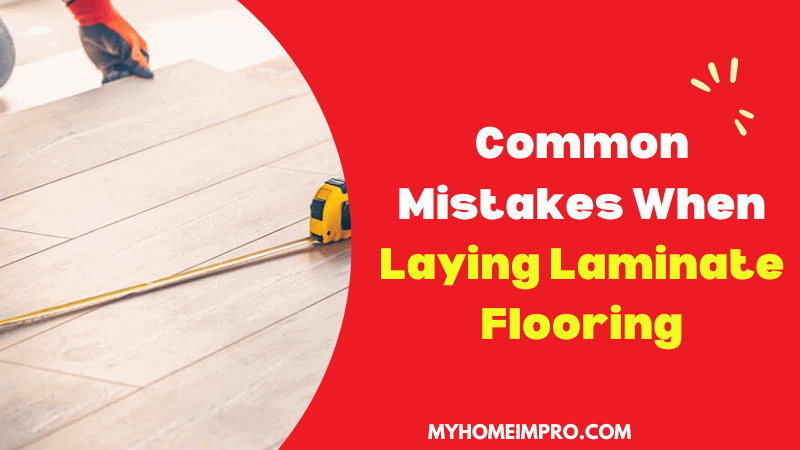Laminate flooring is a popular and affordable option for many homeowners. However, it’s essential to ensure proper installation to avoid common mistakes that can lead to costly repairs or replacements. In this article, we’ll discuss the most common mistakes people make when laying laminate flooring and provide tips on how to avoid them.
Introduction
Table of Contents
Laminate flooring has become a popular choice for homeowners due to its durability, affordability, and aesthetic appeal. However, improper installation can lead to significant issues down the line. Common mistakes include choosing the wrong underlayment, not preparing the subfloor properly, failing to acclimate the laminate flooring, cutting corners with measuring and layout, incorrect spacing between planks, forgetting to leave expansion gaps, and more. In this article, we’ll explore each of these mistakes in detail and provide tips on how to avoid them.
Choosing the Wrong Underlayment
One of the most common mistakes when installing laminate flooring is choosing the wrong underlayment. The underlayment is the layer that goes beneath the laminate flooring, and it’s essential to choose the right one to ensure proper installation. Using an inadequate underlayment can lead to issues such as unevenness, squeaking, and premature wear and tear.
Not Preparing the Subfloor Properly
Before installing laminate flooring, it’s crucial to prepare the subfloor properly. This includes checking for any dips or bumps and ensuring that the subfloor is clean, dry, and level. Failing to do so can result in an uneven and unstable floor.
Failing to Acclimate the Laminate Flooring
Acclimating the laminate flooring means allowing it to adjust to the room’s temperature and humidity before installation. This process helps prevent the flooring from expanding or contracting after installation, which can lead to buckling and warping.
Cutting Corners with Measuring and Layout
Another common mistake when laying laminate flooring is cutting corners with measuring and layout. Failing to measure and cut the planks properly can result in uneven flooring and an unprofessional look.
Incorrect Spacing Between Planks
Spacing between planks is essential when laying laminate flooring. It’s essential to follow the manufacturer’s guidelines for spacing to prevent the planks from buckling or separating over time.
Forgetting to Leave Expansion Gaps
Expansion gaps are essential when laying laminate flooring. These gaps allow the flooring to expand and contract with changes in temperature and humidity, preventing buckling and warping.
Not Using Transition Pieces
Transition pieces are essential when transitioning between different types of flooring or when flooring meets vertical surfaces such as walls or stairs. Failing to use transition pieces can result in an uneven and unprofessional look.
Failing to Check for Moisture
Checking for moisture is crucial before laying laminate flooring. Moisture can lead to mold and mildew growth, and it can also cause the flooring to buckle and warp.
Room temperature and humidity are crucial factors to consider when laying laminate flooring. The room temperature should be consistent, and the humidity level should be within the manufacturer’s recommended range. Extreme fluctuations in temperature and humidity can cause the laminate flooring to warp and buckle.
Poor Installation of Baseboard and Trim
Installing baseboards and trim is an essential step when laying laminate flooring. Poor installation can result in unsightly gaps and uneven edges. It’s essential to take the time to properly install baseboards and trim to ensure a professional-looking finish.
Inadequate Cleaning and Maintenance
Inadequate cleaning and maintenance can lead to the premature wear and tear of laminate flooring. It’s essential to clean spills immediately and avoid using harsh chemicals that can damage the flooring. Additionally, regular cleaning and maintenance will help prolong the life of the flooring.
Incorrect Installation of Underlayment
Incorrect installation of the underlayment can result in an uneven and unstable laminate flooring. It’s essential to follow the manufacturer’s instructions when installing the underlayment and ensure that it’s installed properly.
Not Using the Right Tools and Equipment
Not using the right tools and equipment when laying laminate flooring can result in a poor installation. It’s essential to use the proper tools, including a saw, spacers, tapping block, and pull bar, to ensure that the planks are cut and installed correctly.
Conclusion
Laying laminate flooring can be a cost-effective and beautiful way to upgrade your home’s flooring. However, it’s essential to avoid common mistakes that can lead to costly repairs or replacements down the line. Choosing the right underlayment, preparing the subfloor properly, acclimating the laminate flooring, measuring and cutting the planks correctly, spacing the planks properly, leaving expansion gaps, using transition pieces, checking for moisture, considering room temperature and humidity, properly installing baseboards and trim, adequate cleaning and maintenance, and using the right tools and equipment are all crucial steps to ensure a successful laminate flooring installation.
FAQs
- How long does it take to install laminate flooring?
- The time it takes to install laminate flooring depends on the size of the room and the complexity of the installation. However, a professional installer can typically complete the installation in one to two days.
- Can you install laminate flooring over carpet?
- No, it’s not recommended to install laminate flooring over carpet. The carpet should be removed before installing the laminate flooring.
- Can you install laminate flooring in a bathroom?
- While laminate flooring can be installed in a bathroom, it’s important to choose a laminate that is moisture-resistant and to properly seal the edges to prevent water from seeping under the flooring.
- Can you install laminate flooring over concrete?
- Yes, laminate flooring can be installed over concrete, but it’s essential to ensure that the concrete is clean, dry, and level before installation.
- Is it necessary to hire a professional installer for laminate flooring?
- While it’s possible to install laminate flooring yourself, hiring a professional installer can ensure that the installation is done correctly and can save you time and potential headaches.

